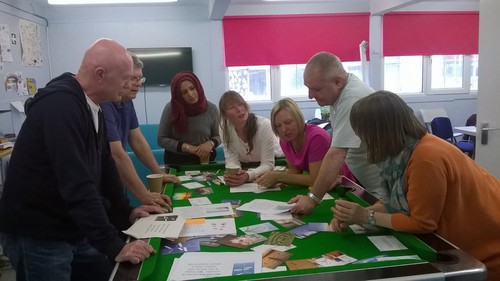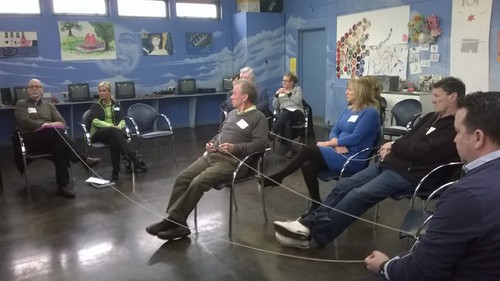
Innovation, imagination and freedom: reflecting on a process of action research
As a public health researcher with experience in epidemiology, needs assessment and traditional methods, the move to becoming a facilitative action researcher took me quite by surprise and initially outwith my comfort zone. I knew about the principles and methodology of action research but with no practical experience I learned on the job with leadership and guidance from skilled practitioners. The opportunity to learn alongside, experience and be part of a new way of carrying out research filled me with great anticipation for what this would mean for me, for those who would be part of the learning with me, but also a sense of apprehension about how we would capture evidence and report our findings.
Our partnership research and learning programme Animating Assets, was interested in exploring the different asset-based approaches – ways of working that recognise, build, value and celebrate the skills, strengths, experience and successes of people and places, made in a number of geographical areas.
Underpinned by a set of values and principles, asset-based working places an emphasis on discovering and mobilising what is already working well (in an individual’s life, community or service), what people care about and the importance of social interactions. In essence it is about building individual and community assets through creating the conditions to engage with, and empower, citizen-led action and participation. These principles actively guided the work of the programme.

Our approach focused on exploring the relationship between asset-based approaches and mainstream service delivery in real time, from real-life situations and in the context of important local issues. This was a fluid, responsive and progressive research approach.
Using a cyclical appreciative approach of ‘discovery’ of what is already working well, ‘dreaming’ of what could be, ‘designing’ what the future could look like and the ‘destiny’ and ‘delivery’ of what will be, the action research penny started to drop for me. The importance of working alongside local people and professionals to try out, develop and learn from different ways of doing things became clear and instilled a sense of shared ownership over the process. The action research approach focused on being community-led – enabling and supporting local collective action, but not directing or controlling it.
Alongside explicitly appreciative, collaborative and creative approaches, the programme had a clear focus on observing, gathering and recording evidence of change with the aim of demonstrating the difference working in an asset-based way makes in the short term (due to funding and time constraints). Firmly rooted in the applied theories of asset-based approaches, appreciative inquiry and action research, participants documented, adapted and reviewed their change in response to local progress and circumstances, with the research team providing different forms of advice, input and facilitation as the work developed locally. Alongside the creative approaches, more traditional forms of research and evidence gathering were also employed, including the development of an evidence and observation framework, reflective and action-orientated notes of meetings, interim reports and in-depth interviews with stakeholders to explore the wider impact of the programme. Storytelling, “our data with soul” played an important role in some sites and digital stories were produced to further capture and share participant experiences of the Animating Assets process. But above all we found out that this way of engaging, building connections and researching “doesn’t just happen” but takes considerable time, effort and preparation.

At the start of the programme, I found the uncertainty of the action research process uncomfortable. Within the programme we had a destination (better partnership working, improved local connections and awareness) but not a direction. Over time and through the use of innovative approaches, imagination, and freedom and trust to practice from the funders, magical things started to happen – energy, enthusiasm and motivation in the room was evident, new connections were being encouraged and established, there was a focus on collaboration not competition and a shared vision for the future was starting to be recognised. This research approach enabled me to be an active, participating observer experiencing first-hand the richness of the process, rather than just being a researcher on the outside looking in.
Finally, Animating Assets was undertaken within the context of a supportive environment where there was clear recognition of the value and importance of the different skills, assets and experiences present within the research team. On reflection for me – across the team we all had different starting points to our understandings of the process, all took time to find our place within the team, and embraced different types of learning through our own Animating Assets journey. The experience of being part of something quite different which has started, we hope, to build sustainable change and potential for the future fills me with great hope! Going back to start of the programme and my intrepid entry into the world of action research, I would now say to others to stick with it, immerse yourself in local learning while having an eye on the bigger picture, be an active part of the process and enjoy the experience.
Animating Assets was an action research programme undertaken in partnership by the Glasgow Centre for Population Health and the Scottish Community Development Centre.
Read more: download the final report.